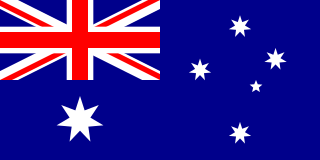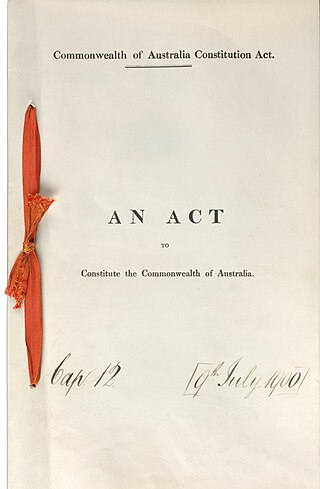Global Affairs Canada is the department of the Government of Canada that manages Canada's diplomatic and consular relations, promotes Canadian international trade, and leads Canada's international development and humanitarian assistance. It is also responsible for maintaining Canadian government offices abroad with diplomatic and consular status on behalf of all government departments.

The Minister of Foreign Affairs, also known as the Foreign Minister, is a senior minister in the New Zealand Government heading the Ministry of Foreign Affairs and Trade and responsible for relations with foreign countries.
A state government is the government that controls a subdivision of a country in a federal form of government, which shares political power with the federal or national government. A state government may have some level of political autonomy, or be subject to the direct control of the federal government. This relationship may be defined by a constitution.
Sir Harry Talbot Gibbs was Chief Justice of the High Court of Australia from 1981 to 1987 after serving as a member of the High Court between 1970 and 1981. He was known as one of Australia's leading federalist judges although he presided over the High Court when decisions such as Koowarta v Bjelke-Petersen in 1982 and Commonwealth v Tasmania expanded the powers of the Commonwealth at the expense of the states. Gibbs dissented from the majority verdict in both cases. On 3 August 2012, the Supreme Court of Queensland Library opened the Sir Harry Gibbs Legal Heritage Centre. It is the only legal heritage museum of its kind in Queensland and features a permanent exhibition dedicated to the life and legacy of Sir Harry Gibbs.
Section 51 of the Constitution of Australia enumerates the legislative powers granted to the Parliament of Australia by the Australian States at Federation. Each subsection, or 'head of power', provides a topic under which the parliament is empowered to make laws. There are other sections in the constitution that enable the parliament to enact laws, although the scope of those other sections are generally limited in comparison with section 51.
Australian constitutional law is the area of the law of Australia relating to the interpretation and application of the Constitution of Australia. Legal cases regarding Australian constitutional law are often handled by the High Court of Australia, the highest court in the Australian judicial system. Several major doctrines of Australian constitutional law have developed.

The second question of the 1967 Australian referendum of 27 May 1967, called by the Holt government, related to Indigenous Australians. Voters were asked whether to give the Commonwealth Parliament the power to make special laws for Indigenous Australians in states, and whether Indigenous Australians should be included in official population counts for constitutional purposes. The term "the Aboriginal Race" was used in the question.

Commonwealth v Tasmania was a significant Australian court case, decided in the High Court of Australia on 1 July 1983. The case was a landmark decision in Australian constitutional law, and was a significant moment in the history of conservation in Australia. The case centred on the proposed construction of a hydro-electric dam on the Gordon River in Tasmania, which was supported by the Tasmanian government, but opposed by the Australian federal government and environmental groups.

Polyukhovich v The Commonwealth [1991] HCA 32; (1991) 172 CLR 501, commonly referred to as the War Crimes Act Case, was a significant case decided in the High Court of Australia regarding the scope of the external affairs power in section 51(xxix) of the Constitution and the judicial power of the Commonwealth.

Koowarta v Bjelke-Petersen, was a significant court case decided in the High Court of Australia on 11 May 1982. It concerned the constitutional validity of parts of the Racial Discrimination Act 1975, and the discriminatory acts of the Government of Queensland in blocking the purchase of land by Aboriginal people in northern Queensland.

WorkChoices was the name given to changes made to the federal industrial relations laws in Australia by the Howard government in 2005, being amendments to the Workplace Relations Act 1996 by the Workplace Relations Amendment Act 2005, sometimes referred to as the Workplace Relations Amendment Act 2005, that came into effect on 27 March 2006.
Section 51(xxix) of the Australian Constitution is a subsection of Section 51 of the Australian Constitution that gives the Commonwealth Parliament of Australia the right to legislate with respect to "external affairs".
The reserved powers doctrine was a principle used by the inaugural High Court of Australia in the interpretation of the Constitution of Australia, that emphasised the context of the Constitution, drawing on principles of federalism, what the Court saw as the compact between the newly formed Commonwealth and the former colonies, particularly the compromises that informed the text of the constitution. The doctrine involved a restrictive approach to the interpretation of the specific powers of the Federal Parliament to preserve the powers that were intended to be left to the States. The doctrine was challenged by the new appointments to the Court in 1906 and was ultimately abandoned by the High Court in 1920 in the Engineers' Case, replaced by an approach to interpretation that emphasised the text rather than the context of the Constitution.
Section 51(xxxvii) of the Constitution of Australia is a provision in the Australian Constitution which empowers the Australian Parliament to legislate on matters referred to it by any state. As Australia is a federation, both states and the Commonwealth have legislative power, and the Australian Constitution limits Commonwealth power. Section 51(xxxvii) allows for a degree of flexibility in the allocation of legislative powers.
Section 51(vi) of the Australian Constitution, commonly called the defence power, is a subsection of Section 51 of the Australian Constitution that gives the Commonwealth Parliament the right to legislate with respect to the defence of Australia and the control of the defence forces. The High Court has adopted a different approach to the interpretation of the defence power, which emphasises the purpose of the legislation, primarily the defence of Australia, rather than the subject matter.

Ruddock v Vadarlis was an Australian court case decided in the Federal Court of Australia on 18 September 2001. It concerned the actions of the Government of Australia in preventing asylum seekers aboard the Norwegian cargo vessel MV Tampa from entering Australia in late August 2001. The Victorian Council for Civil Liberties, and solicitor Eric Vadarlis, were seeking a writ of habeas corpus. The case is significant because it is one of the few cases to consider the nature and scope of the prerogative power of the executive branch of Government in Australia.

The states and territories are the second level of government of Australia. The states are administrative divisions that are self-governing polities that are partly sovereign, having ceded some sovereign rights to the federal government. They have their own constitutions, legislatures, executive governments, judiciaries and law enforcement agencies that administer and deliver public policies and programs. Territories can be autonomous and administer local policies and programs much like the states in practice, but are still legally subordinate to the federal government.

New South Wales v Commonwealth is a landmark decision of the High Court of Australia, which held that the federal government's WorkChoices legislation was a valid exercise of federal legislative power under the Constitution of Australia. In essence, the majority found the Constitution's corporations power capable of sustaining the legislative framework, while the conciliation and arbitration and territories powers were also seen as supporting parts of the law. Furthermore, the majority also held that the legislation permissibly limited State powers and did not interfere with State constitutions or functioning. A minority dissented.

This outline of Australia is an overview of and topical guide to various aspects of the country of Australia:

The Constitution of Australia is the fundamental law that governs the political structure of Australia. It is a written constitution, that establishes the country as a federation under a constitutional monarchy governed with a parliamentary system. Its eight chapters sets down the structure and powers of the three constituent parts of the federal level of government: the Parliament, the Executive Government and the Judicature.






